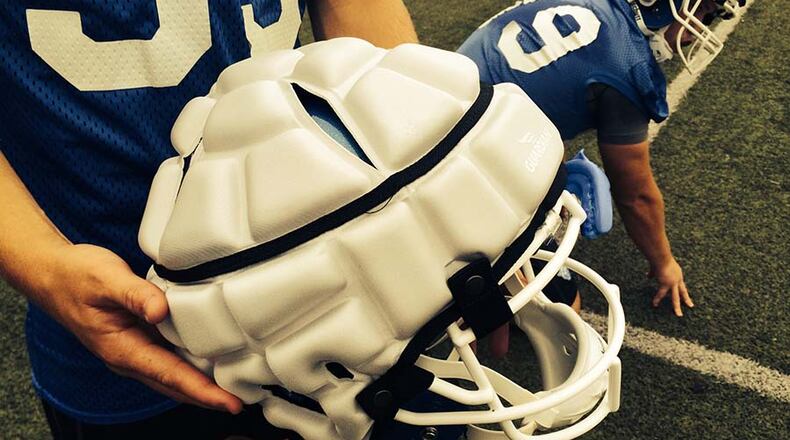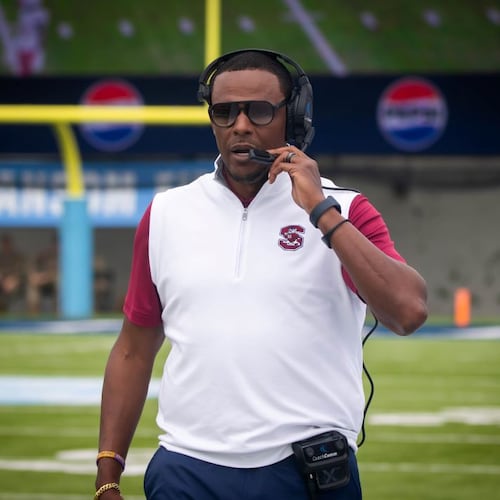On the first day of fall practice at Georgia State, safety Tarris Batiste ran across the field to try to intercept a pass.
As Batiste closed in, the receiver fell down and Batiste’s knee slammed into the side of the receiver’s helmet.
It’s not uncommon after such a collision that the player who was kneed in the head would stay down, or shake his head to clear the fog. But this time, the receiver bounced up and walked off unharmed.
The difference may have been the silver padded shell worn on top of his helmet.
The shell, called Guardian Cap and invented by Atlanta’s Erin and Lee Hanson, is designed to dissipate 33 percent of the force of the impact to the helmet. The goal is to reduce the impact of hits, which can only help players.
“We have to do all we can to put these guys in position where we don’t get them injured,” Georgia State coach Trent Miles said. “Thank God that Guardian helped us with that. We’ve already got the benefits in just one day.”
All Georgia State players are wearing the white shells, which makes them look a little like storm troopers from “Star Wars,” for all practices. The shells contain 39 individual pockets of soft material, weigh less than seven ounces and are fastened to the helmets by snaps and Velcro. Guardians won’t be worn in the games.
Erin Hanson, a graduate of Georgia State, and her husband Lee, a graduate of Georgia Tech, developed a prototype of the Guardian several years ago. Their Alpharetta-based company, the Hanson Group, helps solve other companies’ problems with materials and technology.
They were approached by another company in 2009 about helping to design and produce a football helmet featuring a soft-shelled exterior. They result was the Gladiator, which they took to the NFL’s concussion symposium in New York.
It wasn’t well liked.
“Someone with the league at the concussion symposium said that football is made for TV,” Erin Hanson said. “And if you take away the crack of the helmets hitting, then you take away the sound of the game and people won’t watch anymore.”
The company that had approached the Hansons bailed on the idea, but the couple was undeterred.
“That spurred us on to say, ‘This is ridiculous,’” Erin Hanson said. “Making a sport of the sound of people’s heads clanking together sickened me as a parent and human being. (We said) ‘We are going to do something about this.’”
Realizing that trying to design an all-inclusive helmet was a non-starter, they instead prototyped and finalized the Guardian, which comes as one-size-fits-all for all helmets.
The physics and safety elements boil down to this: The raised pockets absorb the impact. Because the Guardian is attached by snaps and Velcro, it also subtly slides with the impact, further reducing the acceleration and therefore the force of the hit.
The Guardians were tested in 2011 and the first ones were sold in 2012. South Carolina became the first Division I program to have some players use the accessory in the spring 2013, although the Gamecocks quit using them after spring practice this year. A spokesman for South Carolina said he didn’t know why the team stopped using them.
The Hanson Group said this year, more than 30,000 Guardians are in use by at least 10 colleges. Over 300 high school and youth leagues have at least five players on their teams that use the accessory.
Georgia State tight end Keith Rucker, wearing just the helmet, experienced a concussion after a hit last season. Even before the concussion, he said after blocking he would feel “a rattling or shaking” in his head after getting hit above the shoulders.
Wearing the Guardian this year, he said he hasn’t experienced those negative sensations.
The Hansons said there are several reasons why more schools and leagues don’t use the product. Erin Hanson said some are afraid the device voids the warranty on the helmets. Others don’t like how they look while wearing them.
The Hansons have spent more than $1.5 million on the Guardian and have yet to turn a profit. They only recently put it out as a retail product. Sports Authority sells them for $64.95.
“(The price) is more than we’d like it to be,” Erin Hanson said, adding they hope to make it more affordable.
The Hansons said the next step may be to design the Guardian so that the space between the pockets is filled in. Doing so would allow logos to be placed on the Guardians, which would enable them to potentially be worn during games.
Even if the sounds of the game are no longer the same, Erin Hanson said she believes the improved safety would be worth the change.
“In the long run, the only people that are suffering are the players,” she said.
About the Author
Keep Reading
The Latest
Featured



